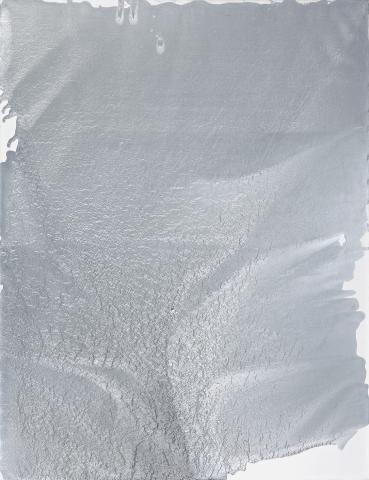SOUND OF BALLS DROPPING, 1996
DALE FRANK
aluminium on canvas
260.0 x 200.0 cm
Anna Schwartz Gallery, Melbourne
Private collection, Sydney
Dale Frank, Social Realism, Roslyn Oxley9 Gallery, Sydney, 6 March – 4 April 1996
The Sound of Two Balls Dropping, 1998, aluminium on canvas, Wesfarmers Collection, Perth
Featuring ponderous slides of molten aluminium, poured across the canvas in layers of varying viscosity and translucency, Sound of Balls Dropping, 1996 encapsulates well Frank’s abiding preoccupation with the universe as a space of constantly evolving relations. Investigating scientific paradigms that expound upon the individual’s connection to larger social and environmental systems, the abstract pours of metallic paint thus suggest molecular and cosmic eruptions, as if the painting itself were a visual representation of energy forces. Such emanations of light not only evoke ideas about space, time and cosmology however. More importantly perhaps, they highlight the very nature of the perceptual experience, drawing attention to the psychological dimension of vision and complicating the customary roles of artist as creator and audience as passive observer.
As witnessed throughout Frank’s oeuvre, here time is invoked as a crucial element in the perceptual experience. Indeed, by allowing the eye to travel over and into the canvas in an unhurried engagement with the very act of looking, our sustained gaze is rewarded with the sensation that we might be looking ever deeper into architectures of space and light that could be infinitesimally and endlessly expanding. So fundamental is this contribution by the viewer to the visual dynamic initiated by the artist, that such involvement may be understood to represent the work’s completion. As Christopher Chapman elucidates, ‘The idea of performance is a core aspect of Frank’s overall practice… He speaks of the ‘black space’ that confronts the individual: it is a void that can only be filled via an intense process of enduring over time. Frank’s artwork comes into being on its own terms, where, like life, one can never be certain of the outcome.’1
Such connotations of infinity and transcendence are reinforced by the monumental scale of the present work which completely absorbs the viewer’s consciousness. That Frank is concerned with an immersive viewing experience is aptly attested by the ‘environments’ which he painstakingly orchestrates to extend the internal dynamics of paintings into the spaces in which they are exhibited. For example, when Sound of Balls Dropping was first exhibited in ‘Dale Frank, Social Realism’ at Roslyn Oxley9 Gallery, Sydney in 1996, the gallery space was lined with expanses of shiny black plastic to reflect the slippery surfaces of the paintings themselves. Similarly, for ‘Ecstasy’, his survey exhibition at the Museum of Contemporary Art, Sydney in 2000, Frank installed paintings to cover expanses of wall space, while others were propped on floor supports and as freestanding ‘sculptural’ objects presented on ladders. Thus, the inner spatiality of the paintings, their appeal to optical and tactile sensation, and their placement within the gallery space itself all purposefully vies for the attention of the viewer.
With his visionary eloquence and technical ingenuity, Frank occupies an esteemed position at the forefront of Australian contemporary art practice. Awarded the prestigious Red Cross Art Award by John Olsen at the tender age of 16, his was a precocious talent and within only five years, he had achieved international recognition with solo exhibitions across Australia, Europe and America. Significantly, in 1983, his work was selected for show alongside Thomas Lawson and Anselm Kiefer at the Museo Palazzo Lanfranchi in Pisa, Italy, and in 1984, he was included in the Aperto section of the Venice Biennale. In 2000, the Museum of Contemporary Art, Sydney mounted the touring survey exhibition of his work Ecstasy: 20 years of painting; in 2005, Frank won the Arthur Guy Memorial Painting Prize at the Bendigo Art Gallery, Victoria and in 2007, his achievements were documented in the magnificent monograph So Far the Art of Dale Frank 2005-1980. Today, his paintings are held in every major public collection across Australia, as well as numerous private and corporate collections around the world.
1. Chapman, C., ‘Dale Frank: Performance into Painting’ in So Far the Art of Dale Frank 2005-1980, Schwartz City Publishing, Melbourne, 2008, p. 343
VERONICA ANGELATOS
